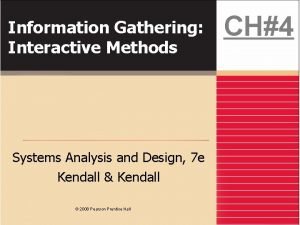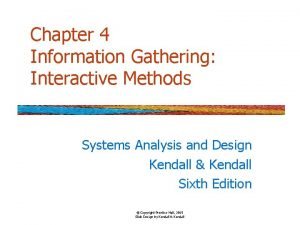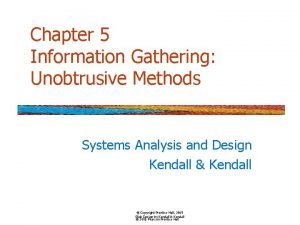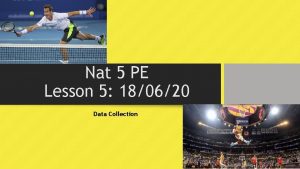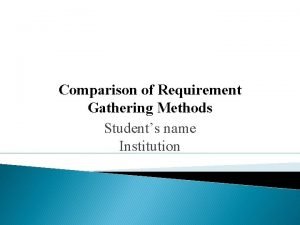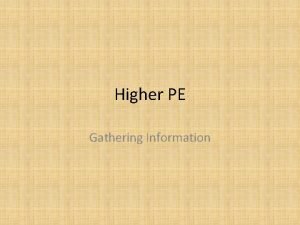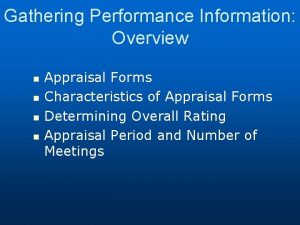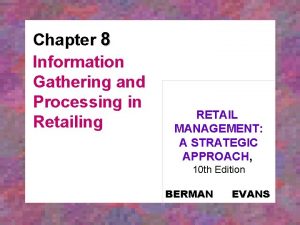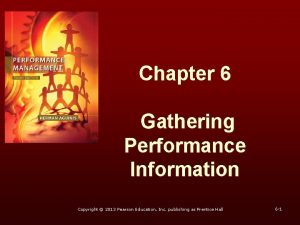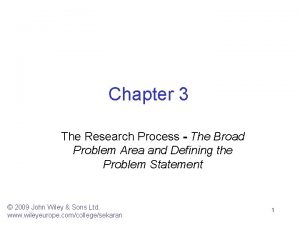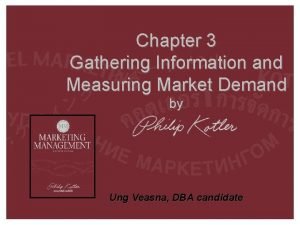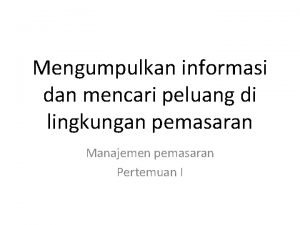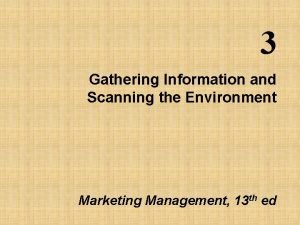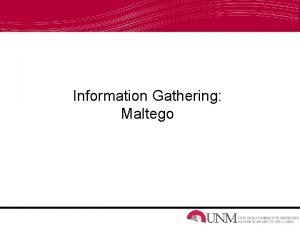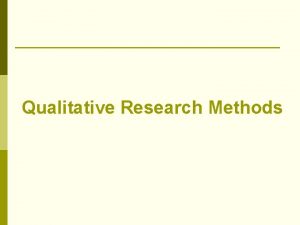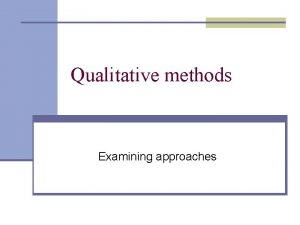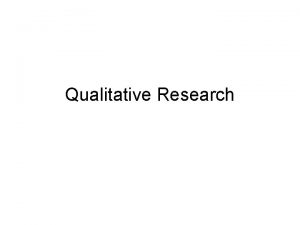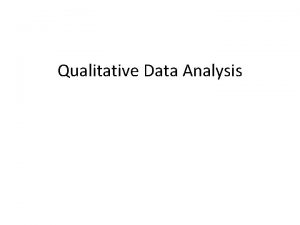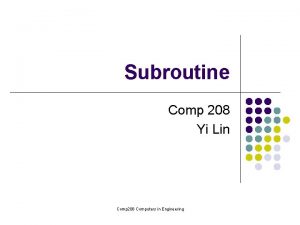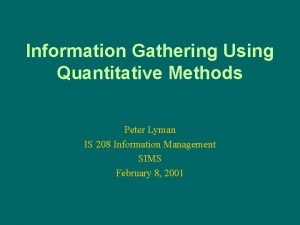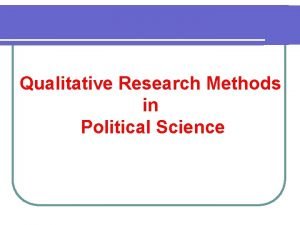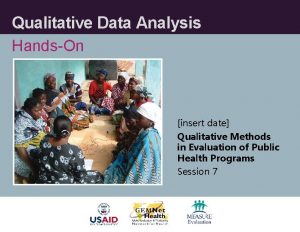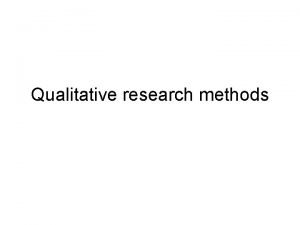Information Gathering II Qualitative Methods IS 208 Peter




















- Slides: 20

Information Gathering II: Qualitative Methods IS 208 Peter Lyman February 13, 2001

Today’s goals A. B. C. D. E. Participant Observation Focus Group Design Analyzing Qualitative Data Managing Group Dynamics Tactical and strategic information gathering

A. Participant Observation The Interview: quantitative and qualitative tstructured interview: note that even a structured interview occurs within the context of a social relationship which must be managed. topen ended interviews: open ended questions allow for unstructured input. These must be coded. tunstructured interviews: essentially recorded conversations, but with themes.

Participant observation Becker & Geer: the interview is essentially hearsay, in that the only thing directly observed is the interview itself. What remains undetected is: tthe native language tfull understanding of what is meant tmatters the interviewee is unable or unwilling to talk about tdistorted lenses

B. Focus group design The focus group is a free flowing discussion guided by a moderator (Knodel) t. Define basic concepts you are investigating to lay out a set of issues for the group to discuss t. Create guidelines for the moderator to follow, while improvising questions and comments to guide the group.

Focus group design. . . Selecting the participant panels: t. You don’t want a debate, you want indepth exploration of different points of view, tso each panel will be homogeneous in composition -- different panels will represent different perspectives or constituencies (“breaks”) t. More than one panel should discuss the issue, until you really understand each

Focus group design You reconstruct the basic issues through texts: ttranscripts from audio recordings tthe notes of observers (one way glass) tsometimes videotape (if nonverbal communications are important) Each is made into a transcript and coded, then analyzed.

Examples t. Market development. Usually there are no ready made customers for innovations, you need to probe to find out what the needs are, and educate the customer about possible future choices. Electric book. t. Formative evaluation. Showing prototypes and mockups of products to customers, asking them to envision their

C. Analyzing the data Unstructured interviews, participant observation, focus groups and ethnography produce long transcripts of conversations. How do you organize the data and analyze them? t Coding (cataloging) the text with metadata t. Searching the text like a database: information retrieval and report

Qualitative data software Storyspace & Filemaker = easy to use basic tools Hyper. Research = Multimedia data linking (easy to use, 30 minutes learning curve) Ethnograph = encoding words and text segments into “project” categories win. Max = code and retrieve both qualitative and quantitative data All these are flexible tools to trace

Qualitative data software t. NUD*IST = hierarchical tree structure, both qualitative and quantitative data t. Atlas. ti = linking different kinds of texts into networks (passages, memos, codes) More complex software allows for graphic representation of textual data. Hierarchical structure is useful for looking for causal relationships.

D. Managing Group dynamics The moderator must understand how group dynamics work to encourage all opinions to surface. What are the problems? t. Groups: usually at least three people, generally 6 to 8, but no more than 12. t. The transactional nature of groups: one person’s actions affect the behavior of all the others. t. Group discussions are a natural human

Group dynamics: the problems t. Compliance: responding to please the interviewer t. Identification: admiration for (or fear of) others gives their opinion undue weight. Group think: participants desire for cohesion preempts their critical examination of options (Survivor) t. Internalization: deeply held personal opinions often withheld from the

Nominal group technique (NGT) When respondents are asked one at a time for their judgements, those responding last tend to echo the sentiments of those responding first. How can the moderator manage this? t. Nominal group technique (NGT) -- each person writes down ideas, then each reads their response. Encourages internalized opinions to surface, grounding the group discussion more.

Delphi technique -- each person writes down ideas, which are posted anonymously. t. Encourages more risky or creative responses (good for brainstorming) t. Encourages more critical analysis, since author is hidden.

Problem solving in groups The usefulness of fantasy themes -“playing roles” -- constructing collective stories. “Future mapping”-- strategic planning sessions to envision options (GBS) t. Commission on Preservation and Access, who will preserve digital documents? t. Getty: The Long Now Foundation t. NRC on educational software.

E. Tactical and strategic information gathering Today’s readings describe information gathering as a stage in project management, but some of the same issues apply to innovation at the firm level. t Note Bezos on learning & innovation

The firm as a learning organization Eliasson on the firm as an experimental machine [p. 11] Board = strategic vision = tacit knowledge Management = command & control = information management Production = operational knowledge The Career = mastering different kinds of knowledge

Information gathering assignment. Design an information gathering protocol and instrument for your project, including quantitative and/or qualitative methods. Pretest the instrument, whether the wording of survey questions or the moderator guidelines for a focus group. Length. 3 pages, double spaced, 12 point fonts. State your strategy in an executive

Comments on papers The executive summary. Often only the first paragraph is read -- it needs to state the problem, your answer, and your reasoning concisely. The reader is mining the document, not surrendering to it. Descriptive narratives (journalism, novels) don’t work -- you need to focus on facts and analysis. Graphics and tables often summarize prose.
 What is information gathering in system analysis and design
What is information gathering in system analysis and design Information gathering: interactive methods
Information gathering: interactive methods Unobtrusive methods of information gathering
Unobtrusive methods of information gathering Methods of gathering data national 5 pe
Methods of gathering data national 5 pe Agile methodology
Agile methodology Cycle of analysis pe
Cycle of analysis pe Gathering performance information
Gathering performance information Information gathering and processing in retailing
Information gathering and processing in retailing Gathering performance information
Gathering performance information Gathering information and measuring market demand
Gathering information and measuring market demand Broad problem area examples
Broad problem area examples Demand measurement in marketing
Demand measurement in marketing Gathering information and scanning the environment
Gathering information and scanning the environment Gathering competitive information
Gathering competitive information Gathering information and scanning the environment
Gathering information and scanning the environment Gathering information and scanning the environment
Gathering information and scanning the environment Gathering activity
Gathering activity Gathering information and scanning the environment
Gathering information and scanning the environment Gathering background information
Gathering background information Gathering background
Gathering background Maltego information gathering
Maltego information gathering
